The Architect’s Challenge – Designing the Best Wall for the Project
Architects Must Take the Lead
While wall design might seem to be the purview of others, from engineers to builders, there is no doubt in the mind of Achilles Karagiozis, a nationally regarded building science expert, exactly who should take the lead to make buildings more durable, safer, and energy and resource efficient.
“The architects’ job is expanding,” Karagiozis says, citing sustainability, extreme energy efficiency, and durability as the architect’s concerns. “No one else has more of that responsibility. Everyone is looking to architects.”
But architects must learn more about building science—the study of the effects of natural forces on structures.
“Building science,” Karagiozis adds, “is key to durable design.”
“It’s lack of education,” agrees Ian Daniels, who holds a master’s degree in architecture and is a technical expert for a company that designs and manufacturers moisture management systems. According to Daniels and others, it would behoove architects to learn how the laws of nature move moisture and temperature into and out of a building.
The Building as a System
Understanding wall design means understanding nature. Here are the immutable laws:
- Moisture moves from wet to dry.
- Energy transfers from hot to cold.
- Pressure moves from high to low.
- Gravity pulls matter down.
Keeping a building dry and conditioned inside is not just one problem to be solved. Success means to balance all factors. If moisture does intrude, as it surely will, the building must be designed so it can dry out. In other words, buildings must be designed for failure.
“Architects need to understand that if they are to be designing energy-efficient structures,” Karagiozis says, “their walls are becoming more and more sensitive to moisture, more and more and more sensitive to air flow.”
A building is, simply put, an environmental separator. Whereas primitive structures once separated occupants and their possessions from lightning strikes, downpours, mountain lions, bears, locust, and other threats, we now demand much more of our building envelopes. In order to function as a superior environmental separator today, the following attributes of a structure must be achieved:
- Control of heat flow
- Control of airflow
- Control of water vapor flow
- Control of rain
- Control of groundwater
- Control of light and solar radiation
- Control of noise and vibrations
- Control of contaminants, environmental hazards, and odors
- Control of insects, rodents, and vermin
- Control of fire
- Provide strength and rigidity
- Be durable
- Be aesthetically pleasing
- Be economical
Control Layers
For a structure to be durable, safe, and healthy, it must be protected by four control layers. Water exists in all three phases (solid, liquid, and gas). These following control layers are deployed to control water (in all phases) and thermal movement:
- Water control layer
- Air control layer
- Vapor control layer
- Thermal control layer
While many configurations are possible in the ever-changing world of material innovation and budgets, the optimum configuration for the control layers is likely to be as shown in Figure 1.
While current building science indicates that control layers on the outside of the structure bring the best moisture and thermal bridging protections, cavity insulation should not be overlooked. According to Karagiozis, the stud cavity is “valuable real estate” that can be insulated to further the building program’s energy efficiency goals.
The most important factor to consider when specifying external control layers is their continuity; they should be continuous around the entire perimeter of the building enclosure, including foundation, walls, and ceiling.
This emphasis on moisture and air control layers has shifted since the beginning of the green building movement, which followed the oil embargo of the 1970s, when most importance was put on thermal control. However, as buildings have become tighter and tighter, the science has shown that controlling the water, air, and vapor going into and out of a structure is actually more impactful for achieving a sustainably-minded architect’s goal—designing a durable building. Only when the forces of moisture intrusion are handled, and controlled ventilation is provided, does the energy efficiency of a building matter. To complicate matters further, each construction material stores water—this specific property is called sorption. Some materials have high affinity to store water (wood), while others like extruded polystyrene (XPS) have very little when placed in the same relative humidity environment.
We’ll take a look first at the role that water-resistant barriers play in the specification of a superior wall. After that, we’ll look at three types of insulation—extruded polystyrene, mineral wood, and fiberglass—and the applications in which each of them contributes to a superior wall design.

Image courtesy Tile of Spain
Figure 1: The best place for the control layers is on the outside of the structure.
Notice

www.ocbuildingspec.com

www.tamlynwrap.com









